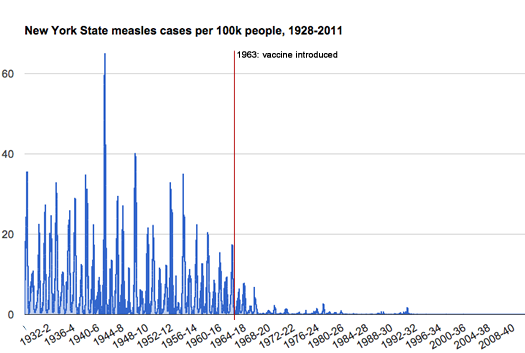Measles in New York, before and after the vaccine

With all the news about the recent upswing in measles cases -- and the all discussions about kids not being vaccinated -- we had been curious about details regarding how a big a difference the measles vaccine made when it was introduced.
A recent Wall Street Journal data visualization illustrates this before/after across the country beautifully. It's based on numbers collected and organized by Project Tycho, a health data project at the University of Pittsburgh.
Project Tycho includes data for many states, including New York. So we pulled out the data for measles cases in New York State between 1928 and 2011. There's a graph above.
There's a bigger version after the jump, along with a few notes.
Larger graph
It's above -- click or scroll all the way up.
A few notes
+ As mentioned, this data is from the Tycho Project at the University of Pittsburgh, based on reports published by the federal Centers for Disease Control and Prevention. It's the number of cases per 100,000 people each week. And some weeks there's no data included. (That's one of the limitations of the graph above -- these no-data weeks look like weeks in which 0 cases were officially reported.)
+ To put some of these numbers in perspective, take a look at that big spike of cases in 1941. The incidence of measles in New York State peaked at more than 66 cases per 100,000 people in March of that year. For the entire year, New York State's measles case count was reported at almost 105,000.
+ The number of cases drops dramatically after the introduction of the vaccine. But there are a few noticeable blips, the latest of which was in 1990 and 1991. There was an outbreak in New York City those years, largely among unvaccinated children (some of them recent immigrants), according to CDC reports and official statements from the time. Over the two years there were more than 5,000 reported cases and 24 deaths.
+ Up until the recent outbreak in California, there had been very cases of measles reported in the United States. Since 2001, many years had fewer than 100 reported cases for the entire country. The count was more than 600 last year.
[WSJ article via @CathleenCrowley]
Hi there. Comments have been closed for this item. Still have something to say? Contact us.

Comments
Thank you for always providing visuals of data for us visual learners, AOA.
... said Sabre on Feb 24, 2015 at 4:00 PM | link